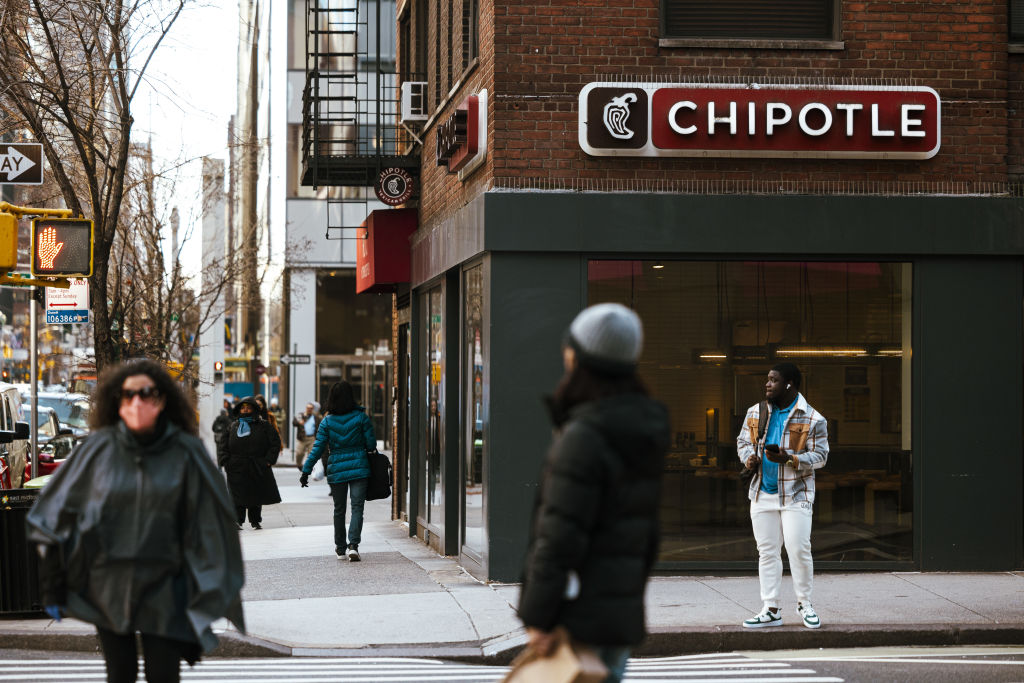What Chipotle Stock's 50-for-1 Split Means for Investors
Chipotle stock will start trading on a split-adjusted basis ahead of Wednesday's open.


Chipotle Mexican Grill (CMG) has given long-term investors plenty to cheer about. Over the past 15 years, Chipotle stock has averaged an annual gain of 28%, easily outpacing the S&P 500's 14.8% total return (price change plus dividends). And the burrito chain's next move could encourage a new crop of folks to look CMG's way.
After the close on Tuesday, June 25, Chipotle underwent a massive 50-for-1 stock split. And CMG stock will begin trading on a post-split basis at the open on Wednesday, June 26.
This marks the first stock split for CMG and one of the biggest in the history of the New York Stock Exchange (NYSE). The split "will make our stock more accessible to employees as well as a broader range of investors," Jack Hartung, chief financial officer of Chipotle, said when the news was first announced back in March. "This split comes at a time when our stock is experiencing an all-time high driven by record revenues, profits, and growth."
From just $107.88 $24.99 for Kiplinger Personal Finance
Become a smarter, better informed investor. Subscribe from just $107.88 $24.99, plus get up to 4 Special Issues

Sign up for Kiplinger’s Free Newsletters
Profit and prosper with the best of expert advice on investing, taxes, retirement, personal finance and more - straight to your e-mail.
Profit and prosper with the best of expert advice - straight to your e-mail.
Indeed, in its first-quarter earnings report, Chipotle disclosed 14.1% year-over-year revenue growth to $2.7 billion. Earnings surged 37% to $13.37 per share. For the second quarter, analysts expect revenue to jump 16% and earnings per share to rise by 23%.
What does the Chipotle stock split mean?
As for Chipotle's stock split, it won't change anything about the company's fundamentals or market valuation. Rather, a stock split is similar to making change. In CMG's case, it will be equivalent to breaking a $50 bill into 50 $1 bills.
Based on CMG's June 25 close at $3,283, the 50-for-1 stock split will bring the share price to a little over $66. This should make it much more attractive for retail investors, as well as Chipotle employees participating in the company's stock purchase plan, who are unable to buy CMG stock at its four-figure share price.
Walmart (WMT) underwent a similar stock split earlier this year. The retailer cited the importance of keeping its "share price in a range where purchasing whole shares, rather than fractions, was accessible to all of our associates" as the reason behind its 3-for-1 stock split.
Nvidia (NVDA) also split its stock recently, while fellow chipmaker Broadcom (AVGO) also announced a major stock split in its fiscal second-quarter earnings report.
Wall Street says Chipotle stock's still a buy
After the news initially broke, Deutsche Bank analyst Lauren Silberman reiterated her Buy rating on Chipotle stock. "CMG has been among the best-performing restaurant stocks and we expect fundamental strength to continue to drive outperformance," Silberman writes in a note to clients.
The analyst adds that she has high conviction in Chipotle's near- and long-term growth outlooks. She believes "a premium multiple is warranted, noting there is scarcity value for a high-quality U.S. company with a clean balance sheet, strong fundamentals and potential upside to numbers."
Silberman is hardly alone in her bullish outlook toward the consumer discretionary stock. Of the 35 analysts covering Chipotle stock tracked by S&P Global Market Intelligence, 21 say it's a Strong Buy, two have it at Buy, 11 rate it a Hold and one has it at Strong Sell. This works out to a consensus Buy rating and with high conviction.
Related Content
Profit and prosper with the best of Kiplinger's advice on investing, taxes, retirement, personal finance and much more. Delivered daily. Enter your email in the box and click Sign Me Up.

With over a decade of experience writing about the stock market, Karee Venema is the senior investing editor at Kiplinger.com. She joined the publication in April 2021 after 10 years of working as an investing writer and columnist at a local investment research firm. In her previous role, Karee focused primarily on options trading, as well as technical, fundamental and sentiment analysis.
-
 12 Tax Strategies Every Self-Employed Worker Needs in 2026
12 Tax Strategies Every Self-Employed Worker Needs in 2026Your Business Navigating the seas of self-employment can be rough. We've got answers to common questions so you can have smoother sailing.
-
 7 Hybrid Adviser Services, Reviewed
7 Hybrid Adviser Services, ReviewedThese hybrid adviser services aim for a sweet spot that combines digital investing with a human touch.
-
 If You'd Put $1,000 Into UPS Stock 20 Years Ago, Here's What You'd Have Today
If You'd Put $1,000 Into UPS Stock 20 Years Ago, Here's What You'd Have TodayUnited Parcel Service stock has been a massive long-term laggard.
-
 7 Hybrid Adviser Services, Reviewed
7 Hybrid Adviser Services, ReviewedThese hybrid adviser services aim for a sweet spot that combines digital investing with a human touch.
-
 If You'd Put $1,000 Into UPS Stock 20 Years Ago, Here's What You'd Have Today
If You'd Put $1,000 Into UPS Stock 20 Years Ago, Here's What You'd Have TodayUnited Parcel Service stock has been a massive long-term laggard.
-
 5 Ways Trump Could Impact Your Portfolio This Year
5 Ways Trump Could Impact Your Portfolio This YearInvestors are facing a changing landscape this year, from lower interest rates to a massive tax and spending bill. Here's how to prepare your portfolio.
-
 This Overlooked Diversification Tool Can Build Resilience Into Your Portfolio
This Overlooked Diversification Tool Can Build Resilience Into Your PortfolioMunicipal bonds can provide a steady income and stability that's separate from federal shifts and global economic headwinds.
-
 What Will Happen to Your Business When You Retire? How to Exit Successfully and Thrive in Retirement
What Will Happen to Your Business When You Retire? How to Exit Successfully and Thrive in RetirementStepping away from work is extra challenging when you're a business owner, and a successful retirement requires planning that looks beyond the financials.
-
 Dow Dives 870 Points on Overseas Affairs: Stock Market Today
Dow Dives 870 Points on Overseas Affairs: Stock Market TodayFiscal policy in the Far East and foreign policy in the near west send markets all over the world into a selling frenzy.
-
 Beyond the Bar: Your 5-Step Guide to Discovering Whether a Lawyer Is Shady
Beyond the Bar: Your 5-Step Guide to Discovering Whether a Lawyer Is ShadyResearch shows you can't rely on some state bar websites to vet a lawyer you're considering hiring. Here's how to check out a lawyer before you hire.
-
 6 Practical Steps to Help Keep Your Student Focused on College Rather Than the Financial Strain
6 Practical Steps to Help Keep Your Student Focused on College Rather Than the Financial StrainToo many students drop out due to financial strain. This plan can help families plan for the costs and get timely aid that sees students through to graduation.